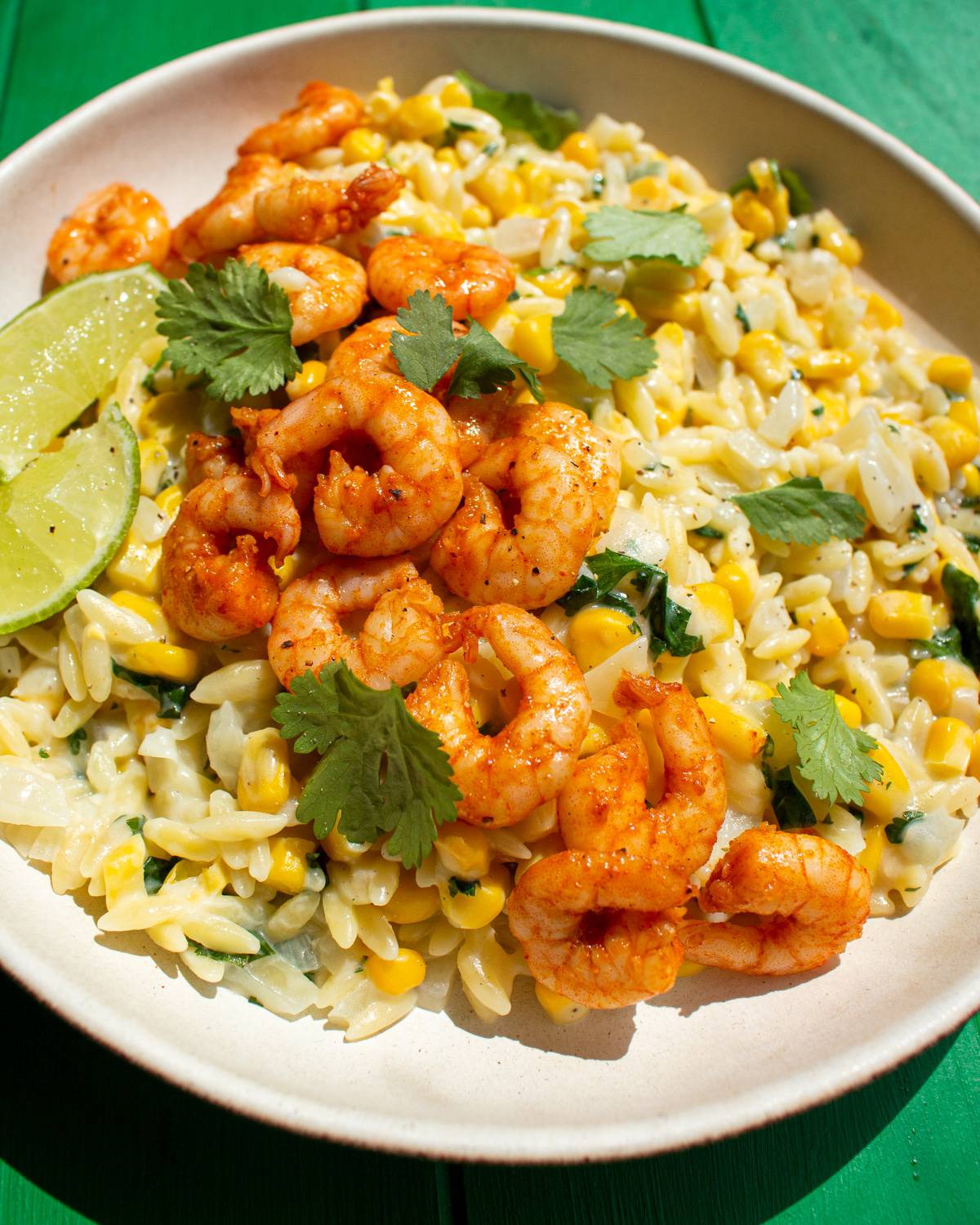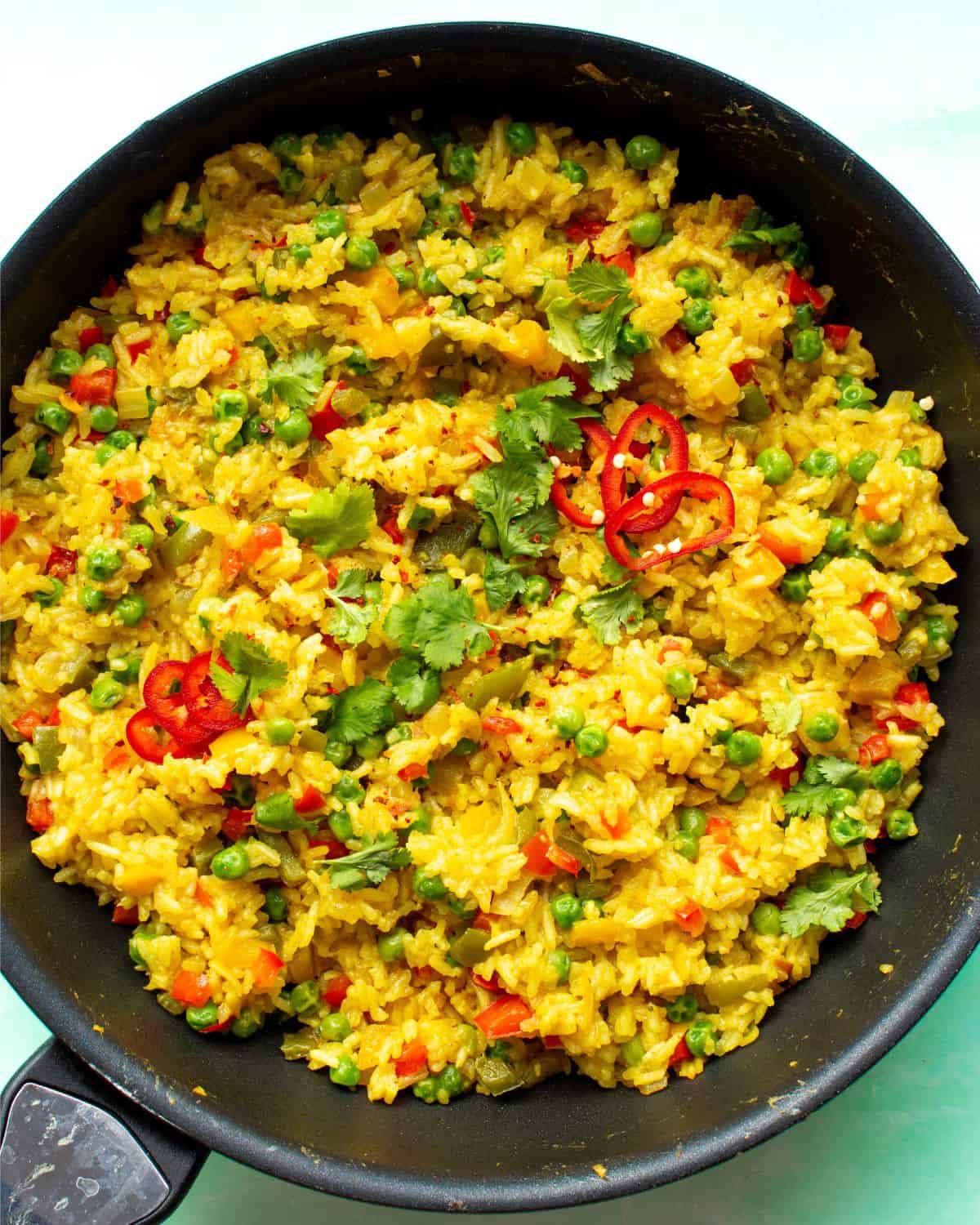12 Best Substitutes for Saffron (Flavor, Color & Ratios)
Want to get the same flavor, color, and aroma of saffron without the hefty price tag? Finding a substitute for saffron is easier than you think. Here are some of the best options to use as a saffron substitute, complete with suggested measurements and recipe ideas.

Table of Contents
What is saffron?
Saffron is the tiny red stigma and styles that come from the saffron crocus. Yep, that’s right, they come from a flower. Many people know this tiny herb as the flavor and color in paella. But in fact, saffron can be used in anything from rice dishes like biryani, to curries, soups, salads and even teas. Because it is so distinct, finding a substitute for saffron can seem tricky, but it is possible.
What does saffron taste like?
Saffron has a distinct flavor that is unlike any other and often hard to describe. It brings an aroma of fresh hay, grass and floral notes combined with the taste of earthiness, honey, and a slight bitterness. The bright red threads leave behind a beautiful yellow hue when used in any dish.
But as many of us know, saffron can be expensive. Finding a substitute for saffron or a good saffron alternative is often necessary to keep costs down.
Why is saffron so expensive?
Saffron is expensive due to the amount of labor it takes to hand pick each of the tiny threads from the crocus flower. The work is extensive, intensive and expensive, leading to its exorbitant price tag of £5.00 to £10.00 or around $10 to $20 per gram (US).
To help offset this price but still find a way to create a similar taste profile and color in your recipes, I have put together a great list if you need a substitute for saffron or a specific substitute for saffron threads.
Quick Guide: Saffron Substitutes Cheat Sheet
If you are in a rush, use this quick list to find the best substitute for saffron based on your needs:
To replace ½ tsp of Saffron:
- For Soups & Broths: Use ½ tsp Safflower
- For Paella & Risotto: Use ¼ tsp Turmeric + ½ tsp Paprika
- For Biryani & Curries: Use ½ tsp Cardamom + ¼ tsp Turmeric
- For Rice Pilaf & Golden Milk: Use ¼ tsp Turmeric Powder
- For Latin Dishes & Oils: Use ½ tsp Annatto
12 Best Substitutes for Saffron when Cooking
1. Safflower
In many places safflower is referred to as “poor man’s saffron”. Some of the qualities that make it similar are that it also comes from a flower and has some of the floral notes like saffron. However, while saffron is said to have honey notes, safflower actually brings more of a chocolate tone to dishes it is used in. Safflower has a sweet taste and a slightly red color, and can be easily used as a saffron replacement.
- Best Used For: Soups, sauces, and light broths.
- Suggested Measurement: 1 tsp Safflower = 1 tsp Saffron
Safflower works wonders in light or creamy soups to add a golden hue. Try using it in my Creamy Leek and Potato Soup, Easy Carrot and Coriander Soup, or Easy Bacon & Lentil Soup.
2. Turmeric + Paprika
In this mix of spices, turmeric brings the distinct yellow saffron color and earthy flavor, while paprika brings some of the sweetness you would typically find in saffron. Using this spice combo is one of the best substitutes for saffron.
- Best Used For: Paella, Spanish rice, and Risotto.
- Suggested Measurement: ¼ tsp Turmeric + ½ tsp Paprika = ½ tsp Saffron
You can use both turmeric and paprika to create the classic paella look in my Easy Chicken and Chorizo Paella, Vegetarian Paella, and One-Pan Cajun Dirty Rice.

3. Cardamom + Turmeric
As we move into this combination substitute for saffron, Cardamom is the main flavor contributor. Cardamom is known to have a bold floral flavor with hints of citrus, which is similar to the floral flavors of saffron. Adding some turmeric as well will lend some earthiness and color to your dish, making it a decent saffron threads substitute.
- Best Used For: Biryani, Curries, and Middle Eastern pilafs.
- Suggested Measurement: ½ tsp Cardamom + ¼ tsp Turmeric = ½ tsp Saffron
This aromatic combo is perfect for authentic curries. Try it in my Beef Keema (Mince Curry), Lentil & Chickpea Curry, or Healthy Chicken Tikka Masala.
4. Turmeric Powder
Some people love to just use turmeric powder as a sub for saffron. With this alternative to saffron, you will definitely achieve the distinctive yellow color and earthiness of saffron.
However the flavor will be missing any sweetness or floral notes. Keep in mind that turmeric has a strong peppery flavor to it, so using too much may affect the flavors of your dish. I recommend starting slow and adding more according to taste. Also, try combining it with other sweeter, more floral spices and herbs to try to get closer in flavor.
- Best Used For: General yellow coloring in rice, soups, and stews.
- Suggested Measurement: ¼ tsp Turmeric Powder = ½ tsp Saffron
Turmeric provides that vibrant golden hue in my Easy Vegetable Rice Pilaf Recipe, Nando’s Spicy Rice, and Easy Red Lentil Dahl.

5. Sweet Paprika
Sweet paprika has a lovely earthy, sweet flavor. Compared to saffron, paprika can deliver on the earthiness and sweetness. But without combining it with another spice or herb, you will not be able to achieve the floral hints or distinctive yellow color that saffron produces. If you are wondering what to use instead of saffron, this is a low-cost option.
- Best Used For: Tomato-based stews and marinades.
- Suggested Measurement: 1 tsp Paprika = 1 tsp saffron (start with this measurement and add more as needed. Paprika can be a somewhat mild spice.)
Paprika adds a lovely depth to my Creamy Sweetcorn Orzo with Paprika Prawns, TENDER Cast Iron Chicken Breast, and Crispy Pan-Fried Salmon Bites.

6. Curry Powder
Due to the depth and complexity of flavors in curry powder, this could be a great substitute for saffron. Curry powder is typically a mixture of spices that can include turmeric, cardamom, cumin, fenugreek and cinnamon. With the different spices already combined, you will find that curry powder can bring some similar flavors of saffron and even add more depth and complexity to your recipe.
- Best Used For: Indian curries, soups, and marinades.
- Suggested Measurement: Start with a little: ¼ tsp Curry Powder = 1 tsp saffron (then add more as needed.)
Curry powder instantly adds complexity to dishes like my Chicken Katsu Curry, Singapore Fried Rice, and Easy Chicken Thigh Curry.

7. Marigold Spice
This peppery and citrusy spice can be used as a saffron substitute in cooking when in a pinch and is often referred to as imitation saffron. Alone, you will not get the earthiness, but you could try combining it with a little turmeric to see if you can get even closer to the saffron flavor. Playing around with flavors is how we discover new ways of making our recipes dynamic and delicious.
One thing to keep in mind with marigold spice is that it can be hard to find. Try looking where health foods and/or ethnic ingredients are sold.
- Best Used For: Salads, teas, and light rice dishes.
- Suggested Measurement: ½ tsp Marigold spice = ½ tsp Saffron
This light floral spice would work well in fresh recipes like my Simple Tricolore Salad, Jennifer Aniston Salad, or Roasted Vegetable Soup.
8. Dried Calendula
Calendula has a somewhat spicy, peppery taste with hints of bitterness that will remind you of a milder saffron. Too much can ruin your dish, so definitely start with a small amount if you decide to use it as a substitute for saffron.
Often, calendula is used as a natural sedative, so please read up on this herb before using it in any recipe you make. You may need to look for dried calendula at your local health food store.
- Best Used For: Broths and herbal teas.
- Suggested Measurement: ½ tsp Dried Calendula = ½ tsp Saffron
You can use this subtle herb in lighter soups such as Best Tomato and Lentil Soup, Vegan Creamy Pea and Mint Soup, or even something like this White Ragu.
9. Cumin
Cumin has a sweet, warm flavor that is slightly nutty. The earthiness of the spice is a great replacement for saffron and can be used in dishes with a little bit of honey to recreate a saffron-like flavor.
- Best Used For: Tacos, rubs, and savory rice.
- Suggested Measurement: ⅔ tsp Cumin + ¼ tsp honey = 1 tsp Saffron
Cumin is a staple in my kitchen! I like to use it for Nando’s Spicy Rice, Easy Burger Bowls and Best Slow Cooker Chilli Con Carne.

10. Annatto
Annatto is slightly nutty, sweet, and peppery. While the flavors may not match saffron well, the color it will add to your dish will be highly reminiscent. Annatto is often used to add natural color to food and can do the same for any recipe that you want to have that yellow substitute for saffron color.
- Best Used For: Latin American dishes, coloring oils, and butter.
- Suggested Measurement: ½ tsp annatto = ½ tsp Saffron
Annatto would be perfect for adding a more vibrant colour to Nando’s Mac and Cheese, Vegan Red Pepper Macaroni and Cheese, or Easy Cauliflower Cheese.
11. Sumac
Sumac, while being a bit tart and sharp, also has hints of sweetness, earthiness and some floral notes, making it a great substitute for saffron. However, the color is pink and therefore will not give your dishes a yellow color but a slightly pink color.
Due to its sharpness, you will want to try adding just a little bit of sumac to your dish so you don’t make your dish overly tart. Sumac can be found in a health food store or possibly a store that sells ethnic foods.
- Best Used For: Dry rubs for meat, salads, and garnishes.
- Suggested Measurement: ¼ tsp Sumac = 1 tsp Saffron (This will however make your dish quite tart, so start off with just a little and add more as needed.)
Sumac (and Za’atar) would add an incredible kick to my Lemon and Thyme Chicken Thigh Tray Bake, Easy Chicken Piccata, and The BEST Crispy Bone-in Chicken Thighs.
12. Food Coloring
And last on the list, if you are just looking to get that characteristic saffron color, I suggest adding a bit of food coloring to your dish. If you are already using an ingredient that will make your dish yellow, such as turmeric or annatto, then be sure to only use a little bit of food coloring.
- Best Used For: Baking and desserts where flavor change isn’t desired.
- Suggested Measurement: 1-2 drops
Tips for the best result
- When trying out a substitute for saffron be sure to take it slow and taste as you go. Figure out what measurements work with your recipe.
- If you find you like the floral notes of cardamom and the earthy, nuttiness of cumin, try combining them in small amounts. If you are wondering how much turmeric to substitute for saffron, start small (1/4 tsp) and combine it with paprika for the best result.
- Buy quality spices. You can save money by finding substitutes for saffron, but you should still buy quality spices as a best practice for cooking in general.
- If saffron is used in your recipe as a coloring agent, then it will be easy to just swap it out for some food coloring. But if the recipe really needs the bitterness, then opting for something like calendula may be just what your recipe needs. Knowing your recipe will help you decide which substitute for saffron will work best.
No Perfect Substitute for Saffron
Ultimately, saffron’s distinct profile is hard to replicate exactly – that’s why it’s so expensive! While there is no single perfect substitute for saffron, finding a convincing saffron thread substitute is definitely possible. You just need to bring out your inner chef and experiment with the diverse flavors these alternatives offer.
FAQs
While there is no such thing as “cheap saffron” (because saffron is just expensive), there are plenty of ways to create a similar taste and color using cheaper herbs and spices. I have listed 12 options above that work as a substitute for saffron.
Is there an imitation saffron?
Yes, spices like Safflower and Marigold are often referred to as “Mexican Saffron” or imitation saffron. While they mimic the color well, they provide a milder flavor profile than true saffron.
No, saffron and cumin are not the same. Saffron is the styles and stigmas taken from the crocus flower and has flavors like grass, hay and honey with a slight bitterness. Cumin however is the dried seed of the plant Cuminum cyminum and has more of a sweet nutty flavor.
There is no one herb that works as a perfect substitute for saffron in paella or other dishes. Using several herbs and spices in combination can help create a similar taste profile and color, though. If you are wondering what can I use instead of saffron, turmeric and paprika are the most common substitute combinations.

